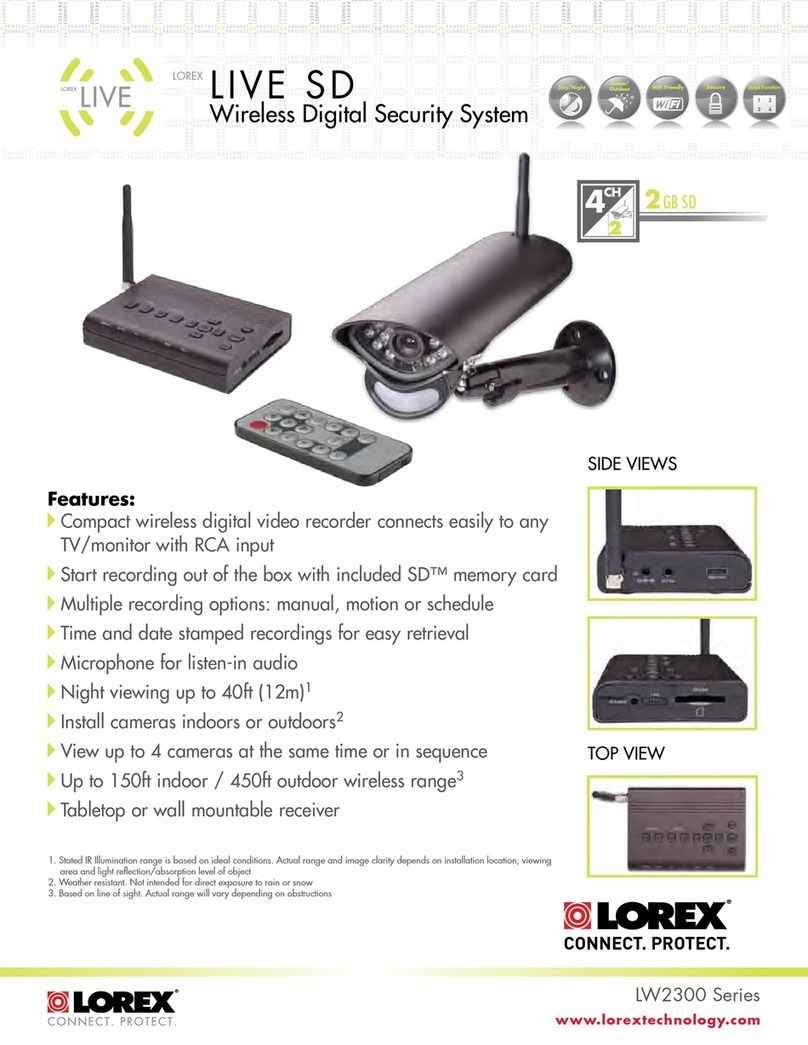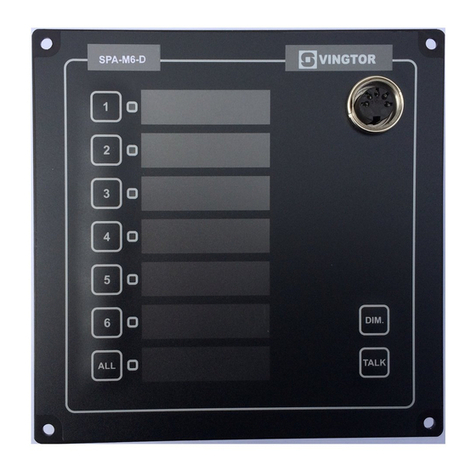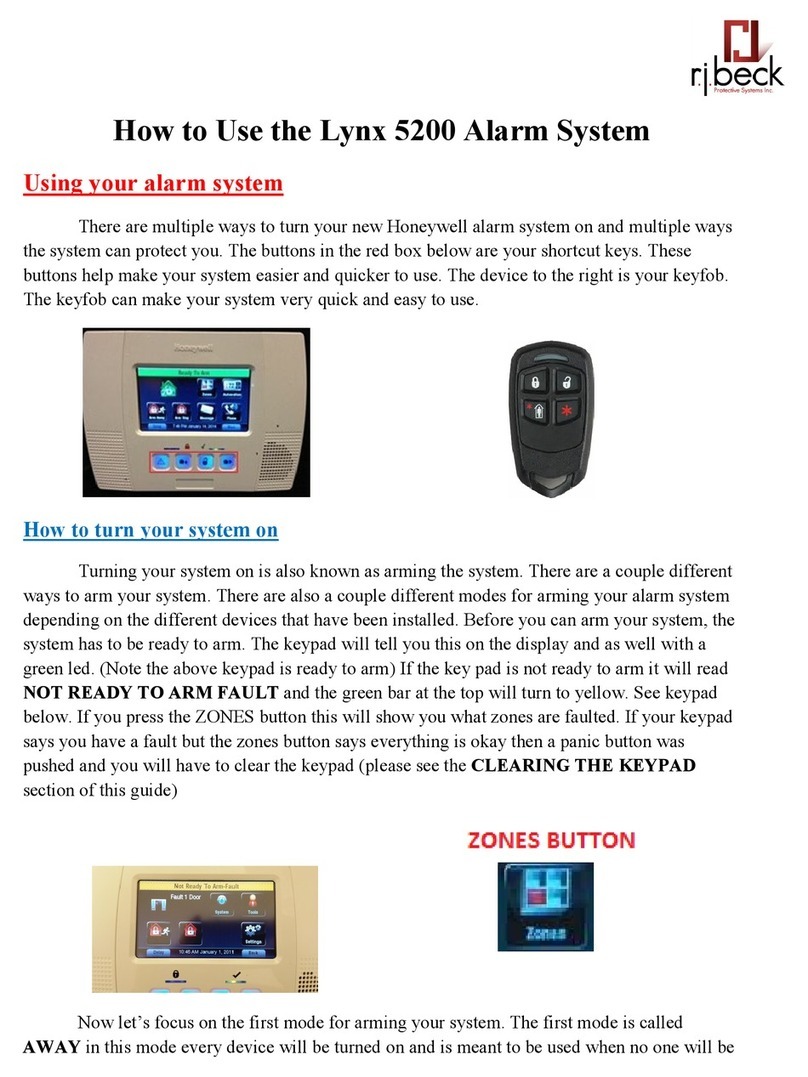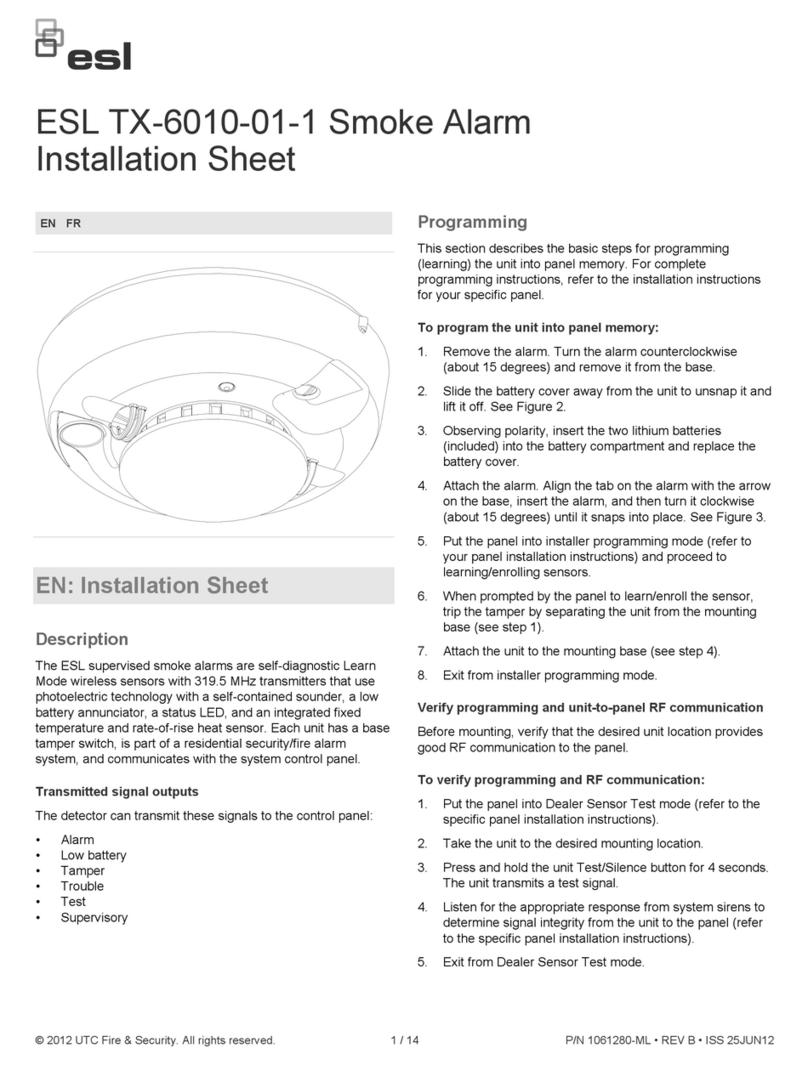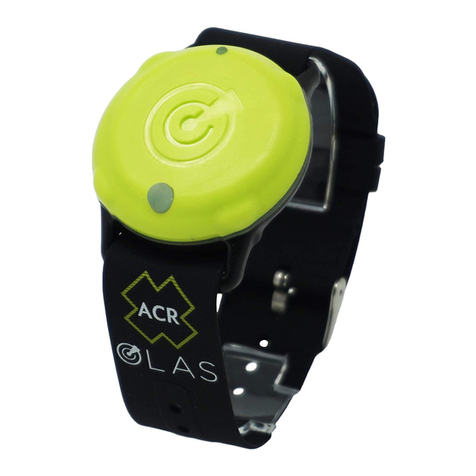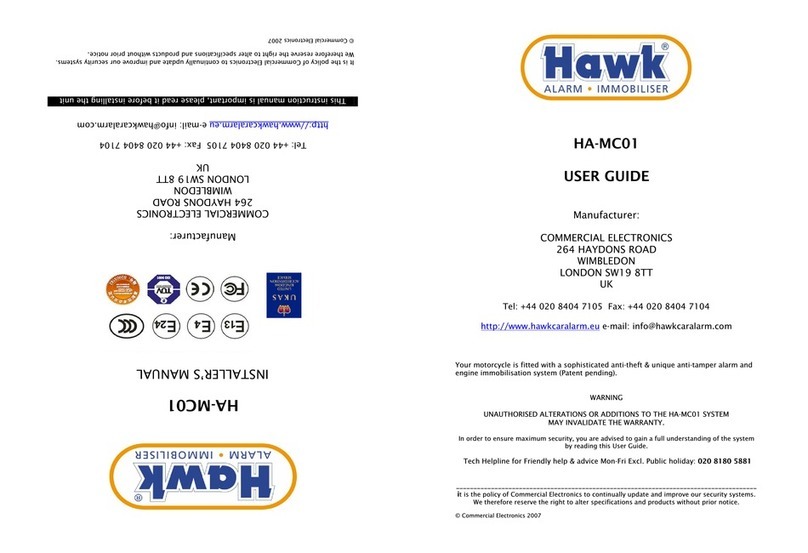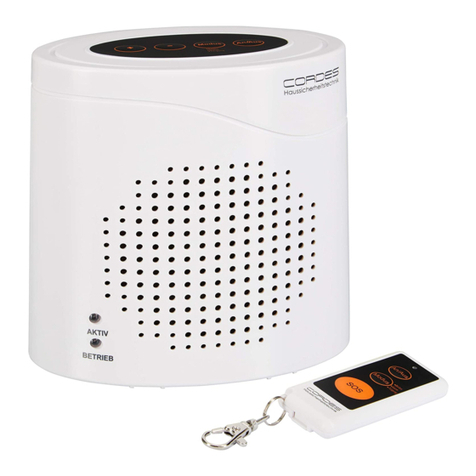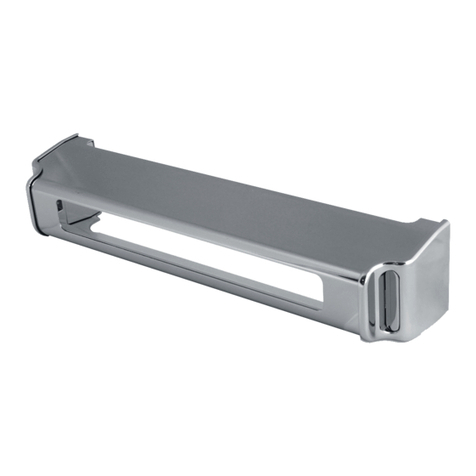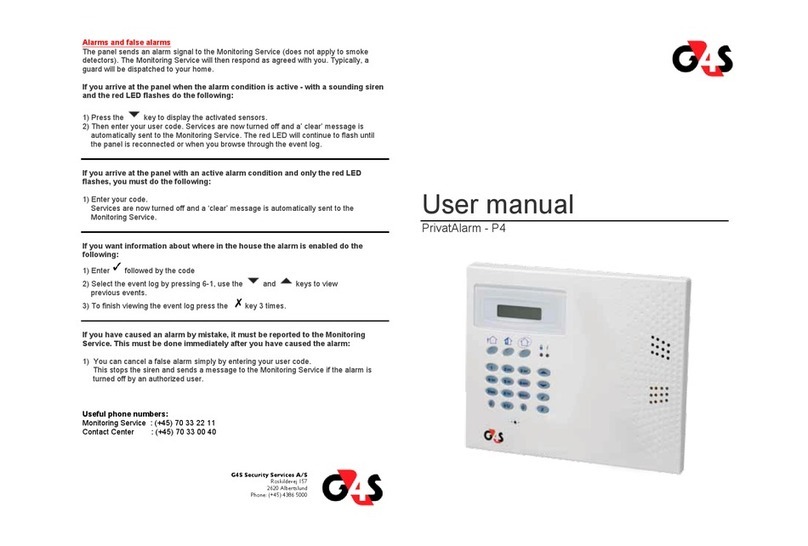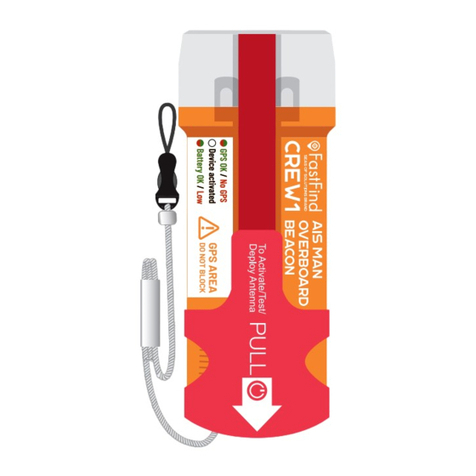TSec SpA MACS User manual

Carefully read this manual in its entirety.
You will find useful information to take full advantage of the product's potential, use it safely and obtain the best results.
MACS
Anti-intrusion perimeter system for rigid and
semi-rigid metal fences
Instruction manual
v1.1 - EN

Copyright © 2018, TSec SpA
All rights reserved in all countries.
Any distribution, alteration, translation or reproduction, partial or total, of this
document is strictly prohibited unless with prior authorization in writing from TSec
SpA, with the exception of the following actions:
lPrinting the document in its original format, totally or partially.
lTransferring the document on websites or other electronic systems.
lCopying contents without any modification and stating TSec SpA as
copyright owner.
TSec SpA reserves the right to make modifications or improvements to the relative
documentation without prior notice.
Requests for authorization, additional copies of this manual or technical
information on the latter, must be addressed to:
TSec SpA
Via Gavardina Traversa I, 74
25081 Bedizzole (BS)
Italy
info@tsec.it
www.tsec.it
+39 030 57 85 302

Contents
Reception 5
Package contents 5
Get to know MACS 6
Introduction to MACS system 7
System start- up 8
The sensors (MACS- S3H) 8
The Master (MACS- MAS) 9
The Ethernet board (MACS- ETH) 11
Connection to the Ethernet board 12
Web interface 12
System installation 14
Things to know 15
Before installing the system 17
Install the sensors 18
Install the Master 21
Install the Ethernet board 23
System configuration 24
General concepts about sensors 25
Initial operations 26
Operate with the web interface 27
Diagnostics and maintenance 30
Diagnostics and troubleshooting 31
Firmware and web interface updates 32
Maintenance and cleaning 32
Appendix 33
Technical data 34
Disposal 36
Service and warranty 36
MACS| Instruction manual v1.1 11- 2018 |MACS_instructions_en_v1.1|© 2018 TSec SpA iii

4MACS| Instruction manual v1.1 11- 2018 |MACS_instructions_en_v1.1|© 2018 TSec SpA
Updates to the instruction manual
Publication date Code Updates
11- 2018 MACS_instructions_en_v1.1 First publication
Provided documentation
Manual Code Date Format Distribution
Instruction manual (this manual) MACS_instructions_en_
v1.1
11-
2018
PDF Website www.tsec.it
MACS Installation instructions MACS_installation_en_
v1.0
01-
2019
Printed Supplied in MACS
packaging
MACS- KIT- CON Joining kit Installation
instructions
MACS- KIT- CON_
installation_en_v1.0
01-
2019 Printed Supplied in Joining kit
packaging
MACS- KIT- TERM Termination kit
Installation instructions
MACS- KIT- TERM_
installation_en_v1.0
01-
2019 Printed Supplied in Termination
kit packaging
Intended users of this instruction manual
Recipient Assignments Skills
Safety system designer lDefines the composition of
the system
Safety system expert
Installer lInstalls all system
components
lConfigures the system
Safety system expert
Maintenance technician lPerforms maintenance on
the system
High technical knowledge in the field of safety
systems
System owner / safety
manager
lMonitors the system -

Reception
Package contents
Sensor package
lPre- wired sensor chains
lFor each sensor:
llong and short screw
lcounter- plate
lT- cap
lspacer
lInstallation instructions
Master package
lCircuit board in watertight case
lFour screws per cover
Ethernet board package
MACS-ETH:
lCircuit board with support for DIN rail
lDIN rail
lMagnet
MACS-ETH-PS:
lCircuit board in metallic box with wired power supply unit (input: 230 V ac)
lMagnet
lBuffer battery (optional)
lInstallation instructions
Material excluded
lBus cable for connection of the Ethernet board and Master and for prolonging the intervals between
sensors.
lTermination kit.
lPossible cable joining kit.
lPossible self- drilling screws for installation of sensors on pole.
lEthernet cable to connect the Ethernet board.
Spare parts and accessories
For orders and consulting the spare parts and accessories catalog, contact the local distributor or
manufacturer.
Reception
MACS| Instruction manual v1.1 11- 2018 |MACS_instructions_en_v1.1|© 2018 TSec SpA 5

6MACS| Instruction manual v1.1 11- 2018 |MACS_instructions_en_v1.1|© 2018 TSec SpA
Get to know MACS
Contents
This section includes the following topics:
Introduction to MACS system 7
System start-up 8
The sensors (MACS-S3H) 8
The Master (MACS-MAS) 9
The Ethernet board (MACS-ETH) 11
Connection to the Ethernet board 12
Web interface 12
Get to know MACS

Introduction to MACS system
Description
MACS is an anti- intrusion perimeter system for rigid and semi- rigid fences with metallic panels higher than
1.50 m (4.92 ft) and total height (panel and wall) over 1.70 m (5.57 ft).
Thanks to an accelerometer inside of each sensor and a proprietary algorithm, the system detects and signals
vibrations caused by climbing over the fence and other potentially damaging actions (e.g. attempted removal
of the fence). Furthermore, it distinguishes and filters innocuous vibrations caused by involuntary actions, like
accidental impacts or weather.
Control of the system is divided between two components, the Ethernet board and the Master. The Ethernet
board is the only component of the system to which supply power, the Master and the sensors receive power
supply from the Ethernet board. The system is configured and monitored via the web interface, accessible by
browser.
Main components
Component Code Description
Sensors MACS-S3H Up to 2 chains with 120 sensors each (bus 1 and bus 2)
Master MACS-MAS Electronic circuit board for managing the sensors
mounted in the watertight case for outdoor installation
Ethernet board MACS-ETH Communication electronic circuit board with the alarm
control panel and Ethernet port for access to the web
interface
Get to know MACS
MACS| Instruction manual v1.1 11- 2018 |MACS_instructions_en_v1.1|© 2018 TSec SpA 7

8MACS| Instruction manual v1.1 11- 2018 |MACS_instructions_en_v1.1|© 2018 TSec SpA
Component Code Description
Bus cable MACS-CAB Proprietary bus cable
Web interface - Interface accessible by browser to configure and manage
the system
Applications
The system is suitable for large fences (e.g. military sites, airports, industrial sites, etc.) as well as residential
and commercial sites.
System start-up
System start-up
The sequence of macro- procedures for starting up the system is presented as follows:
1. "Install the sensors" on page18.
2. "Install the Master" on page21.
3. "Install the Ethernet board" on page23.
4. "Initial operations" on page26.
5. "Manage system settings" on page28.
The sensors (MACS-S3H)
Functioning
The sensors detect the vibrations caused by motions of the fence thanks to an accelerometer and send the
signals to the Master via bus. The algorithm recognizes attempts to climb over the fence by filtering out
vibrations caused by accidental impacts or weather.
Sensor front
Part Description
ASensor body
BHole for fastening screw to pole or counter- plate
CBus cables
DT- cap
Get to know MACS

Sensor back
Part Description
ACounter- plate for panel installation
BSpacer for panel installation with thick mesh
CRubber fastening gasket
The Master (MACS-MAS)
Functions
The Master performs the following functions:
lManages the sensor chains.
lTransmits signals from the sensors to the Ethernet board.
Main components
Part Description
AWatertight box
BTerminal block for connecting sensor chains (see "Description of terminal block for connecting
sensor chains" on page22)
Get to know MACS
MACS| Instruction manual v1.1 11- 2018 |MACS_instructions_en_v1.1|© 2018 TSec SpA 9

10 MACS| Instruction manual v1.1 11- 2018 |MACS_instructions_en_v1.1|© 2018 TSec SpA
Part Description
CTerminal block for connecting Ethernet board (see "Description of terminal block for connecting
the Ethernet board " on page22)
DCable glands, for bus cables of the two sensor chains and towards the Ethernet board
LED
LED Color Description
LD2 Green Power supply status:
lSteady: powered up.
lOff:not powered up (see "LED of the Master" on page31).
LD9 Green Power supply status bus 2:
lSteady: powered up. In the start- up and configuration phase, the LED turns off for a few
seconds and then turns back on.
lOff:not powered up (see "LED of the Master" on page31).
LD10 Red Short- circuit bus 2:
lSteady: short- circuit
lOne flashing: short- circuit detected. The Master attempts to power up the bus again and
the LED turns off. If the short- circuit is detected again, the LED turns back on and stays on.
LD11 Green Power supply status bus 1:
lSteady: powered up. In the start- up and configuration phase, the LED turns off for a few
seconds and then turns back on.
lOff:not powered up (see "LED of the Master" on page31).
LD12 Red Short- circuit bus 1:
lSteady: short- circuit
lOne flashing: short- circuit detected. The Master attempts to power up the bus again and
the LED turns off. If the short- circuit is detected again, the LED turns back on and stays on.
LD15 Green Firmware status:
lFlashing: normal functioning.
lSteady or off: malfunctioning (see "LED of the Master" on page31).
Orange Sensor configuration status:
lSteady: configuration in progress. The sensor alarms are not read. The LED turns off after
about 30 s of inactivity in the web interface.
lOff: configuration concluded.
Get to know MACS

The Ethernet board (MACS-ETH)
Functions
The Ethernet board performs the following functions:
lPowers the other system components.
lReceives signals from the sensors through the Master.
lSignals alarms to the control unit through outputs.
lAllows configuration of the system through the web interface.
Main components
Part Description
ATerminal block towards the Master and for system power supply (see "Description of terminal
block towards the Master and for power supply" on page23)
BEthernet port
CTerminal block towards the alarm control panel (see "Description of terminal block towards the
alarm control panel" on page23)
DLabel with serial number of the Ethernet board
EReset button
LED
LED Color Description
LD10 Red Reset in progress (see "Reset the system" on page31).
LD11 Green Power supply status:
lSteady: powered up.
lOff:not powered up (see "LED of the Ethernet board" on page31).
LD14 Orange Enabled connection option (see "Connection to the Ethernet board " on the next page):
lSteady:through the serial number of the controller and IP address.
lOff: only through IP address.
Get to know MACS
MACS| Instruction manual v1.1 11- 2018 |MACS_instructions_en_v1.1|© 2018 TSec SpA 11

12 MACS| Instruction manual v1.1 11- 2018 |MACS_instructions_en_v1.1|© 2018 TSec SpA
LED Color Description
LD15 Green Network connection status:
lRapid flashing: search in progress.
lSingle slow flashing: through dynamic IP.
lDouble slow flashing: through static IP.
lOff: no connection.
LD16 Green Firmware status:
lFlashing: normal functioning.
lOff or steady:malfunctioning (see "LED of the Ethernet board" on page31).
TMP Orange Tampering:
lSteady and all 01–08 steady: total system fault or error in start- up phase. The system has
encountered faults in the saved configurations.
lSteady and at least one among 01- –08 steady: sensors tampering in the zone(s) indicated
or bus short circuit.
lOff: no tampering.
01-
08
Orange Climbing alarm:
lAll steady: fist start- up or restored factory default settings. The system has no sensors
saved in the memory.
lSteady: climbing alarm from at least one sensor of the indicated zone(s).
lAlternating flashing: system configuration in progress.
lOff: no alarms.
Connection to the Ethernet board
Connection options
Three connection options are available:
lStatic IP
lDynamic IP
lSerial number of the Ethernet board (see "Default settings" below)
The network settings define the enabled connection options and can be modified through the web interface
(see "Manage system settings" on page28).
Consult the network administrator to identify the best configuration.
Default settings
The preset connection options are:
lStatic IP: 192.168.0.45
lController serial number: printed on the label of the Ethernet board (e.g. macs00000000)
Web interface
Functions
The web interface is used to perform the following functions:
lConfigure the sensors.
lAssociate the sensors with monitoring zones and alarm outputs.
lEnable/disable the sensors.
lMonitor the system status (sensors, zones, outputs).
lDownload the sensor log file.
lManage the system and network settings.
lManage the users and relative permissions.
Get to know MACS

Access procedure
1. Make sure that the monitoring computer is connected to the network where the Ethernet board is
located and open the web browser.
Note: to check compatibility of the browser with the web interface, access the link www.tsec.it/browser-check-
macs/.
2. Insert the address assigned to the Ethernet board in the address bar:
To connect... Then type...
through the serial number of the controller
(default)
https://serialnumber.local (e.g.
https://macs00000000.local)
through static IP (default) https://192.168.0.45 (default IP) or set static IP
through dynamic IP https://serialnumber.local (e.g.
https://macs00000000.local)
Note: if a security warning appears, see "Troubleshooting" on page31.
3. Insert the user name and password (default "installer", "installer") then click Login.
Main menu
For instructions on how to use the web interface, see "Operate with the web interface" on page27.
Note: the available functions may vary based on the permissions of the users.
Page Function
Dashboard Monitor outputs, zones and sensors in real time.
Sensors Select a sensor for:
lDisplay the sensor in the Dashboard.
lChange the sensor configuration.
Configurations Consult, change, eliminate and rename the configurations.
Settings lDisplay and change the system settings (e.g.date and time, user management)
and network settings.
lManage firmware updates.
lDownload the sensor log file.
Get to know MACS
MACS| Instruction manual v1.1 11- 2018 |MACS_instructions_en_v1.1|© 2018 TSec SpA 13

Things to know
Sensor chains
The sensors are supplied pre- wired in a chain. The sensor chains can be connected to one another to reach
the necessary number of sensors for covering the entire fence. Each chain can be made up of a maximum of
120 sensors.
Cables
lMaximum length of bus cable between the Ethernet board and the Master circuit board:1000 m
(3280.84 ft)
lMaximum length of bus cable for a chain of sensors: 800 m (2624.67 ft)
lInterval between sensors:6 m (19.68 ft)
Sensor
lFor continuous coverage, the maximum distance for installing two sensors is 5 m (16.40 ft).
NOTICE: the actual range of coverage of the sensors varies based on the type of fence.
lFor greater vibration detection, the sensor must be installed at a height equal to half the panel/pole or
higher.
Maximum coverage
The maximum coverage for the complete system (2 chains of 120 sensors each) is 1200 m (3937 ft). If the
fence to be protected has a length over 1200 m (3937 ft), more than one MACS system must be installed.
The maximum coverage does not take into account any interruptions in the fence (e.g. gate, wall, methane
column). For example, for the section of fence represented in the illustration, the system coverage is 12 m
(39.37 ft). 4 m (13.12 ft) of wall and 4 m (13.12 ft) of gate are excluded.
Interruptions in the fence
In the case of interruptions in the fence, the interval between the sensors must be increased by making a cable
joint.
System installation
MACS| Instruction manual v1.1 11- 2018 |MACS_instructions_en_v1.1|© 2018 TSec SpA 15

16 MACS| Instruction manual v1.1 11- 2018 |MACS_instructions_en_v1.1|© 2018 TSec SpA
The length of the cable necessary for covering the interruption must be considered in the calculation of the
total length of the cable. In the example presented in the illustration, the length of the cable in the section is 29
m (95.14 ft).
Types of sensor installation
To adapt to different types of fences, the sensors can be installed in three ways:
lOn thin mesh panels: thickness from 4 to 13 mm (from 0.15 to 0.51 in)
lOn thick mesh panels: thickness from 24 to 28 mm (from 0.94 to 1.10 in)
lOn the pole: in the case of panels with mesh thicker than 28 mm (1.10 in) or for special needs
Where possible, opt for installation on panel.
Example of installation on a thin mesh panel
System installation

Example of installation on a thick mesh panel
Example of installation on pole
Before installing the system
Material required
lBus cable for connection of the Ethernet board and Master and for prolonging the intervals between
sensors (product code MACS- CAB- 100 or MACS- CAB- 300).
lTermination kit, one for each sensor chain (product code: MACS- KIT- TERM or MACS- BOX- CON).
lPossible cable joining kit (product code: MACS- KIT- CON or MACS- BOX- CON).
lPossible self- drilling screws for installation of sensors on pole.
lEthernet cable to connect the Ethernet board.
lBranch cable from the alarm control panel with conductors necessary to connect the Ethernet board.
lOnly for MACS- ETH, for independent power supply from the alarm control panel, 12 V 3 A power supply.
System installation
MACS| Instruction manual v1.1 11- 2018 |MACS_instructions_en_v1.1|© 2018 TSec SpA 17

18 MACS| Instruction manual v1.1 11- 2018 |MACS_instructions_en_v1.1|© 2018 TSec SpA
Install the sensors
Installation precautions
lInstall the sensors with the cable outlet hole turned downwards.
lPerform the cable joints with special care. The system reliability depends on it. Refer to the instructions
provided with the cable joining kit.
Prepare the sensor for thin mesh panels
1. Mount the counter- plate on the sensor.
2. Fasten the counter- plate to the sensor by partially
tightening the provided short screw.
Prepare the sensor for thick mesh panels
1. Mount the spacer on the counter- plate.
System installation

2. Mount the counter- plate on the sensor, inserting
the spacer in the hole.
3. Fasten the counter- plate to the sensor by partially
tightening the provided long screw.
Install the sensors on the panel
Note: as an example, the illustrations refer to a thin mesh panel.
1. Position the sensor with the counter- plate outside
of the fence.
Make sure that the gasket touches as much of
the mesh as possible (e.g. on a cross-piece).
System installation
MACS| Instruction manual v1.1 11- 2018 |MACS_instructions_en_v1.1|© 2018 TSec SpA 19

20 MACS| Instruction manual v1.1 11- 2018 |MACS_instructions_en_v1.1|© 2018 TSec SpA
2. Tighten the screws and make sure that the sensor
is firmly mounted.
3. Mount the T- cap.
4. Properly fasten the cables with cable ties.
5. Proceed by mounting the other sensors of the
chain and connecting more chains if necessary.
6. After the last sensor of the chain, install the
termination kit. Refer to the instructions provided
with the termination kit.
Install the sensors on the pole
1. Establish the installation point and fasten the
sensor with a self- drilling screw (not supplied),
then make sure that the sensor is firmly mounted.
System installation
Table of contents

